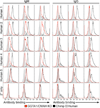Reduced binding of human antibodies to cells from GGTA1/CMAH KO pigs
- PMID: 24909344
- PMCID: PMC4366649
- DOI: 10.1111/ajt.12744
Reduced binding of human antibodies to cells from GGTA1/CMAH KO pigs
Abstract
Xenotransplantation using genetically modified pig organs could solve the donor organ shortage problem. Two inactivated genes that make humans unique from pigs are GGTA1 and CMAH, the products of which produce the carbohydrate epitopes, aGal and Neu5Gc that attract preformed human antibody. When the GGTA1 and CMAH genes were deleted in pigs, human antibody binding was reduced in preliminary analysis. We analyzed the binding of human IgM and IgG from 121 healthy human serum samples for binding to GGTA1 KO and GGTA1/CMAH KO peripheral blood mononuclear cells (PBMCs). We analyzed a sub population for reactivity toward genetically modified pig PBMCs as compared to chimpanzee and human PBMCs. Deletion of the GGTA1 and CMAH genes in pigs improved the crossmatch results beyond those observed with chimpanzees. Sorting the 121 human samples tested against the GGTA1/CMAH KO pig PBMCs did not reveal a distinguishing feature such as blood group, age or gender. Modification of genes to make pig carbohydrates more similar to humans has improved the crossmatch with human serum significantly.
Keywords: Antibody-mediated rejection; crossmatch; genetically modified pigs; xenotransplantation.
© Copyright 2014 The American Society of Transplantation and the American Society of Transplant Surgeons.
Conflict of interest statement
The authors of this manuscript have no conflicts of interest to disclose as described by the
Figures



References
-
- Burlak C, Wang Z-Y, Chihara RK, Lutz AJ, Wang Y, Estrada JL, et al. Identification of human preformed antibody targets in GTKO pigs. Xenotransplantation. 2012 Mar;19(2):92–101. - PubMed
-
- Reemtsma K, McCracken BH, Schlegel JU. Renal Heterotransplantation in Man. Annals of … [Internet] 1964 Available from: http://www.ncbi.nlm.nih.gov/pmc/articles/PMC1408776/ - PMC - PubMed
-
- Starzl TE, Marchioro TL, Peters GN, Kirkpatrick CH. RENAL HETEROTRANSPLANTATION FROM BABOON TO MAN: EXPERIENCE WITH 6 CASES. … [Internet] 1964 Available from: http://www.ncbi.nlm.nih.gov/pmc/articles/PMC2972727/ - PMC - PubMed
-
- Hardy MA, editor. Xenograft 25. Amsteram: Elsevier Science Publishers B.V.; 1989. p. 1.
Publication types
MeSH terms
Substances
Grants and funding
LinkOut - more resources
Full Text Sources
Other Literature Sources
Research Materials

